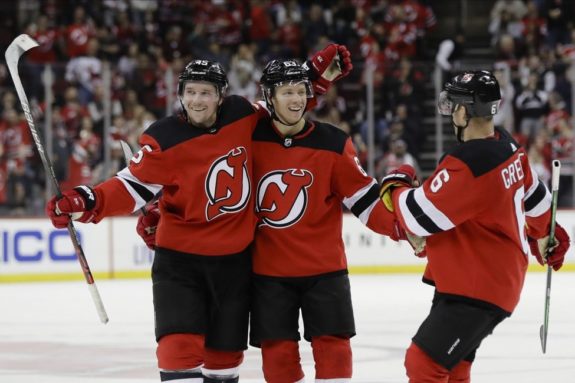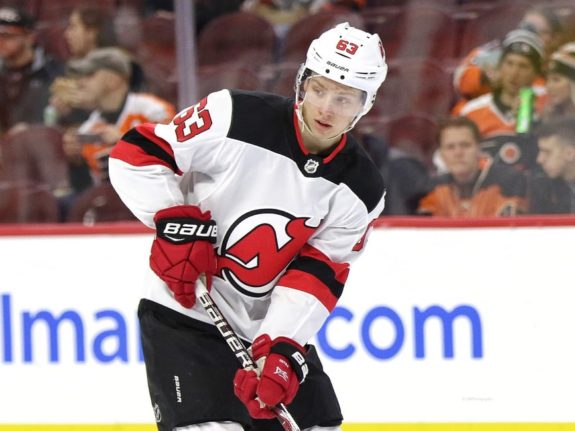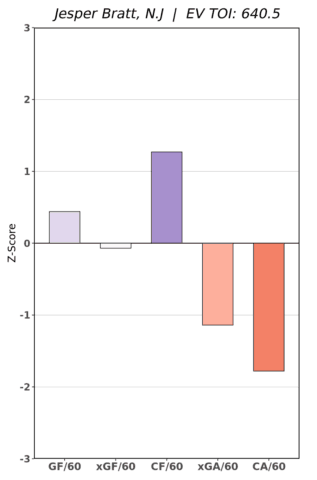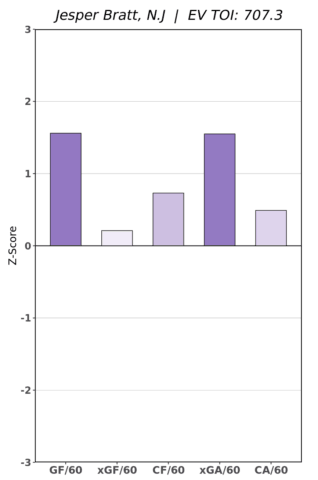Jesper Bratt was supposed to be a major factor for the New Jersey Devils in 2019-20. That happened eventually, but it was a tale of two seasons for the former sixth-round pick from Sweden. He finished with 32 points in 60 games, which comes out a 44-point pace over 82 games. But an overwhelming majority of those points came after the team fired head coach John Hynes on Dec. 3. Here’s a look back at his season and what lies ahead for him 2020-21.
Bratt’s Topsy-Turvy Season
To say Bratt had two different seasons would be an understatement. He started on the team’s second line with Nikita Gusev and Jack Hughes, two of the Devils’ top offseason additions, but things did not go well. Hynes moved Bratt off that line after just one game, and his usage after then became rather curious.
Over the next few weeks, Bratt found himself moving around the bottom six, and he was even a healthy scratch on a few occasions. His five-on-five, on-ice stats suffered, as he had a Corsi share (CF%) of 47.03% and expected goals share (xGF%) of 44.86% until Dec. 2, the day Hynes coached his final game with the team. He also had just seven points in 21 games, as well as only 24 shots on goal.

But things did change once Alain Nasreddine took over as the team’s interim head coach. In 39 games after the coaching change, Bratt finished with 25 points (12 goals, 13 assists), with 16 points over his final 20 games. He also had a noticeable improvement in his on-ice stats, as his CF% was 48.89%, while his xGF% of 53.14% ranked second on the team (min. 100 minutes played). He was also the team’s most efficient scorer, averaging 2.35 points per 60 minutes (points/60).
While the uptick in scoring and offense was a significant positive, Bratt also made notable strides defensively. In his second NHL season (2018-19), he had a negative impact on defense; the same was true as a rookie too. But it could be argued he was one of the team’s best defensive forwards in 2019-20, as he had a strong positive impact.
* * *
Another stat worth considering in evaluating Bratt is goals above replacement (GAR), which shows how many goals a player adds to his team relative to a replacement-level player. In 2018-19, Bratt finished with a GAR of 2.8 in 51 games, placing him 11th on the Devils. That jumped to 9.6 this season, putting him third on the team to only Kyle Palmieri and Blake Coleman.
A significant reason for that was because of his improved two-way game. He had the best even-strength offensive GAR on the team. But his even-strength defensive GAR ranked third and was second among forwards to only Coleman. And that should open up options for where he plays in the lineup moving forward.
What’s Next for Bratt?
Bratt played particularly well on two different lines after the coaching change. The first was taking over as the top line’s left-wing with Nico Hischier and Palmieri after the Devils traded Taylor Hall to the Arizona Coyotes. The second being with Pavel Zacha and Gusev over the final few weeks of games.
Related: Devils’ Draft Strategy Could Hinge on Their Needs
With Bratt, Hischier, and Palmieri as a unit, the Devils found instant success. They had an xGF% over 57% and controlled over 65% of the high-danger chances when they were on the ice. They also outscored their opponents 10-2. So not only were they generating dangerous shots and chances, but they were also converting on them.
The pairing of Bratt, Zacha, and Gusev doesn’t seem like the best fit on paper, but they worked well together. They had a CF% above 52%, as well as an xGF% of 51.7%, over the final 10 games of the season. Bratt and Gusev seemed to benefit from playing with each other this time around, unlike when the season began. Bratt had five goals over his last 10 games, while Gusev had eight assists.

Because of his defensive improvement, Bratt can play as a top-line winger moving forward. It also wouldn’t be a surprise to see Gusev continue being one of his linemates. His pass-first mentality, along with Bratt’s underrated shooting ability, could make for a lot of scoring. With that said, Zacha most likely isn’t a long-term solution as their center.
Related: Devils’ Bratt Elevating His Game to New Heights
The option that may make the most sense is having Hischier center Gusev and Bratt. Gusev may be the Devils’ top offensive weapon, but he’s never going to be a standout defender. Any line he’s on will need forwards with defensive prowess. Hischier has been lauded for his two-way game since he broke into the league, so he’s an obvious choice to have alongside Gusev. That wouldn’t have been the case with Bratt a season ago, but his defensive game has seen incredible progress. There’d also be plenty of offense between the three forwards, so it should make for a relatively balanced line.
Bratt Ready for Primetime Role
Even with the slow start, Bratt was one of the Devils’ best forwards this season. The next step is doing it consistently because he can’t have seven points in 21 games to start 2020-21. I’d be surprised if that happens again, but his role in the lineup will factor into that too. Though, it’d be odd if he’s playing anywhere else than in the top six. And with the way he closed out this season, he should be ready to handle those minutes on a full-time basis.
* * *
Advanced stats from Natural Stat Trick, GAR from Evolving Hockey

